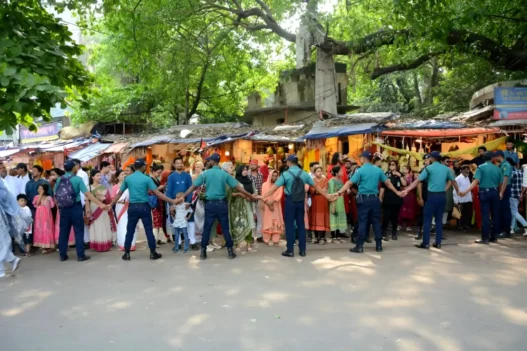Keynote lecture at the launch of The Borderlens at Shillong, on September 19.
– Gautam Mukhopadhaya
Since the leitmotif of this talk is ‘Rethinking’, let me start with deconstructing some of the key words of the title: Borderlands, Livelihoods, Security, and Connectivity. Implicit or concealed in those words are some other keywords that matter: People, Power, Environment…..I hope I can bring them out too because they affect or are affected by, each of these elements.
In doing so, I will l draw from the considerable literature on the intimate link between thought, language, meaning, knowledge and power. Words come sedimented with meaning but also multiple shades, and vary depending on one’s vantage point or position – whether one is at the ‘centre’ or the ‘periphery’, or above or below in the power structure. But every ‘periphery’ is also a ‘centre’ even if the inverse is not entirely the case. There is a built-in asymmetry in it that makes one the ‘centre’ and the other the ‘borderlands’.
Where one sits in relative to each other and the power structure makes a big difference to words and meanings. It would therefore be useful to interrogate these words for what they mean to the North East from that angle to overcome some of the challenges of history, politics and livelihoods that we face. Meanings can also change, and can be changed. Rethink can also be to ‘act’, ‘re-do’ or ‘re-create’.

First, ‘Borderlands’: One of the key points is that the idea of ‘borderlands’ is affected by history and by our angle of vision depending on where we are positioned vis-a-vis the Centre or the ‘mainland’, or the ‘borderlands’, both problematic terms that are not easy to replace. I have taken two dimensions of the idea: historical and political.
Historically, the idea of the North East as ‘Borderlands’ is new. The NE may not have been a major theatre of Asian history or trade, and it may have been to some extent on the margins of South Asian and South East history, but it was part of a continuum with its neighbours – the Himalayan states of Tibet, Nepal and Bhutan, Burma, Bengal and eastern India with its share of history in the form of the rise and fall of empires, migrations and military campaigns notably those of the Tai Ahoms (part of the movement of the Tai peoples out of southern China), and the Konbaungs of Burma (although I must say in passing, that it escaped one, perhaps the most important historical force that came to Asia before the advent of imperialism and colonialism: the Mongols, who reached as far as Burma albeit fleetingly when one of Kublai Khan’s generals ransacked Bagan to the east, and up to Bengal through the Mughals).
The idea of the North East as ‘borderlands’ is thus a product of colonial history, independence, partition, and the emergence of modern ‘nation-states’. They brought hard frontiers to a region where borders were elastic, expanding and contracting with the rise and fall of political authority, looser or tighter depending on relationships, and graduated or mediated through forms of allegiance such as paying tribute, accepting suzerainty, regional satraps and imperial agents.
While ‘rethinking’ the idea of ‘borderlands’ today does not mean that we have to go back in time or history, or redraw settled political borders, it does mean making these borders as irrelevant as possible as former PM Man Mohan Singh dreamt of in the context of our western borders, or better still, to convert these areas from borderlands to bridges between historically relatively new political entities.
This is easier said than done. It cannot be done unilaterally. It has to involve neighbours in a mutual and shared regional vision and partnership. That has not always been possible. For the better part of the last 75 years, our region has been troubled, and our relations with our neighbours have not always been cooperative.
Even today, our relations with China are antagonistic; Myanmar is turbulent and likely to remain so; relations with Nepal, accident prone; and with Bangladesh, like Nepal, intimate but often personality-centric and delicate.
Rethinking the ‘borderlands’ has, therefore, at its core, to be a mutual economic and environmental project that sees the region as a single economic and ecological space from the Himalayas to the Bay of Bengal and beyond. Bangladesh is key. [But while there has been much progress on trade and transit issues with Bangladesh and a new Comprehensive Economic Partnership Agreement (CEPA) with Bangladesh is on the agenda, we are still far from such a vision or goal.]
Political Dimension: Second, ‘borderlands’ also has a political and security dimension. I have broadly identified 2 angles of vision, a ‘national’ angle or a view from the Centre or ‘mainland’, and a local or regional angle. Both have complex variations.
At the risk of simplification, we can speak of a national ‘security’ lens, where the NE tends to be looked at from the Centre or ‘nation’ as a ‘national’ or internal security issue. This is an occupational hazard for people like Prof. Kondapalli and me who look at inter-state relations, geo-politics and the macro-picture. It is also inevitable for a region that is strategically located between China (with whom we have a serious boundary and territorial issue), Myanmar, Bangladesh and the Bay of Bengal, sharing international boundaries with them and Bhutan and Nepal, disconnected from the sea, and barely connected to India physically through the militarily vulnerable Siliguri corridor. It is necessary but it has its implications for the region.
There is also an ‘integrationist’ point of view that looks at the region, again from the point of view of the ‘mainland’, as insufficiently integrated for reasons of geography, ethnicity, politics, culture, language, race or religion, and therefore needing greater ‘integration’ to the national mainstream through political, economic, cultural and security strategies. These include, at its extreme, the AFSPA.

Outside the security and integrationist lens, there is what we can call a benign, ’romantic’ lens, where well-meaning Indians look at the region from the point of view of its natural endowments of forests, wildlife, hills, mountains, rivers, and bio-diversity, and as a showcase for India’s great cultural diversity.
The inverse of this is a majoritarian, mainland ethnocentric, and chauvinist if not racist view that looks at the region and its peoples as somehow alien and ‘less Indian’ in terms of race, religion, language and culture. I need hardly elaborate. In recent years, there have been several ugly manifestations of such a view.
The problems with all these ‘gazes’ is that the people of the North East ‘Borderlands’ as real people with their own problems and views of their homeland, is somehow missing or glossed over. The entire region is ‘objectified’ through pre-determined prisms remote from their own.
Rethinking ‘borderlands’ therefore also implies a shift away from thinking as a region from the point of view of the Centre or mainland alone, or largely from the security, integrationist, romantic or ethnocentric point of view, to one rooted in the needs and interests of the people of the NE and the rest of the country, and its neighbours.
But when we turn to the region for an answer to this, that too is elusive. I am not native to the NE, so I may be excused for thinking that a shared and coherent vision of the North East based on its geography, location and cultural commonalities is lost in the topographical variations – of rivers, plains, hills valleys and mountains especially the Brahmaputra/Barak and hills/plans divides – and its rich ethnic palimpsest. The dominant lens is a parochial, ethnic or tribal lens that sees Indians in general as ‘outsiders’, other local tribes as rivals or even anti-thetical (and obsessed with identities and sub-divisions), and immigrants as unwelcome.
But there is a large section including those relatively the most politically, economically and intellectually ‘integrated’ to India who unwittingly look at the region from a refracted ‘national’ lens, internalising, but at the same time, resisting, much of the discourse around the ‘North East’ and ’borderlands’. Not surprisingly, it is this segment that is the most attached and most conflicted in its relationship with India.
Each of these ‘lenses’ is at a tangent from the other. They do not converge. They hardly intersect. In the process, they do not do justice either to the potential of the region nor the country. One of its most telling symptoms is the almost total dependence of a naturally bountiful region on the Centre, its inability to stand on its own feet, and it’s utter lack of agency visible in its impotence in dealing with issues such as the AFSPA.
This is not helped by the fact that although the Centre has created regional institutions to serve the region such as the NEC and DONER, the region itself does not have a coherent vision of itself as a region beyond ethnicities and tribes, or taken possession of its destiny as a whole. For various reasons, most leaders of the region are contented to confine themselves to their states or their own ethnic groupings.
Of course, there have always been efforts at looking beyond, epitomised by figures like S.C. Jamir in Nagaland and Meghalaya’s own Purno Sangma. In more recent years, we have seen the formation of the NEDA and Conrad Sangma’s NPP. But perhaps the most promising initiative is the now 10-year initiative of young leaders in the form of the North East Young Leader’s Connect who recently adopted the brief Tawang Declaration. The Declaration is a succinct agenda for the lens through which a new generation is seeing the North East and its relationship with the rest of India and the region. At its base, it is imperative that the North East achieves some viability as an economic unit. This can come from building on its existing livelihood profile.

Livelihoods: It is self-evident that the pre-colonial economy of the region, and therefore also livelihoods, was essentially pastoral, dependent on nature, forests rivers, ponds, livestock, fishing and small-scale subsistence farming. In many ways, it still is.
Colonialism marked a major rupture in the economic life of the North East hijacking or appropriating part of it to the imperial trade and economy through essentially large-scale extractive industries like timber, rice, coal, oil, tea and other plantation crops and leaving the rest to its traditional subsistence economy.
That colonial economy was never really sustainable once empire collapsed, leaving the region politically partitioned, economically landlocked, administratively fragmented, ‘geo-politically’ fractured between the mountains (Himalayas, Patkai and its extensions, Khasi-Garo-Jaintia hills) rivers, plains, the delta (Sunderbans) and the Bay of Bengal coast, and rightly severed from imperialism. But it has been chugging along, effectively within a dual economy, part extractive or productive and linked to the market economy, and, part subsistence and largely outside.
This colonial legacy seriously affected the regions economic viability. But they also reflect failures of imagination, vision, politics and administration of both the Centre and the States post-independence.
75 years later although there have been positive developments in investments, indigenisation, output, value-adding, employment generation, services including government service, tourism, IT and trade, the economy that of the NE at its base, remains largely extractive, dropping some, but adding others like large dams and hydro-electric projects, large-scale plantations, new mining concessions in sensitive areas, rock quarrying, river bed mining, rat hole mining etc. whose damage in the long run may be even greater. These are causing huge damages that we are seeing every day: oil spills, soil erosion, landslides (Tupul), floods (Haflong) in unlikely places, encroachment of wetlands, mining in protected areas, poor road, rail and infrastructure construction, etc. but conveniently turn our eyes away from.
Worse, today, the pressures on the environment and livelihoods closely linked to the forests, rivers, hills and plains come as much from large government or government-sponsored ‘development’ projects (like poorly constructed roads, railways, infrastructure etc.), as commercial exploitation (mining, real estate development, polluting industries including oil and gas), and quest for livelihoods (such as stone quarrying, sand mining, deforestation, poppy cultivation etc), in an increasingly unstable natural environment affected by climate change. At some level, we are all guilty – governments, businesses, and ordinary people.
Once again, the solution is not to revert to some romantic and idyllic pre-colonial, pre-industrial state but to build on the environmental, ownership and land use patterns of the past to add a market dimension to the subsistence economy in a variety of ways. In my article, I have suggested a menu of ways in which this could be done starting with the restoration of forests and habitats from the upper altitudes and ridges to the valleys, and bottom-up approaches to enhancing the productivity of small farms through natural and sustainable methods so that they have surplus for the market to add to their traditional food and land security with badly needed cash income. [It does not replace subsistence farming with cash crops, but adds cash crops and processed produce to subsistence farming.] As this market expands to include neighbouring countries it could also act as a powerful pull for entrepreneurship, value-adding, employment generation and ‘Acting East’ as we are already seeing in various parts of the North East.
Security: I have already dealt with one of the consequences of looking at the region from a ‘national security’ lens, however necessary, in the objectification of the region in terms of territory over people. I don’t want to be misunderstood. Defending national territory against an aggressive neighbour that has used force in the past and even now, to grab territory and maintains a threatening posture, is an imperative. It cannot be compromised. It comes with the NE’s strategic location and our relationship with some of our more trouble some neighbours. Regardless of its remaining insurgencies, the North East is fully behind this.
It is also important from the point of view of internal security. Without external security, we cannot have internal security. The State has a duty to protect its citizens.
Third, the presence of security forces have also brought manifold benefits to the local populations in terms of development, roads, services, employment, assistance to civilian authorities in times of need, disaster response and so on. These cannot be gainsaid. Net, it has far more benefits than costs.
There is also the dimension of digital security which has both a national and human component that I am not touching because there are many more people more capable of talking about it. The national component is obvious. But the human content includes data and privacy that is also a matter of concern.
But there are also ways looking at security other than national and internal security: what is often called ‘Human Security’ that includes Human Rights, Food Security, Livelihood Security, Personal Security, Security of land, and Environmental Security on which our food, water, livelihood, security of land, and even the air, derives.
At its most basic, what people everywhere need and want from any authority, is personal safety and security, feeling safe at home, safe to move, travel. This is particularly true for women who are particular targets of violence and trafficking.
If we are honest, can we say that our concern for internal security has not come at a cost of some personal security in the region?
Can we say for sure that this has only to do with national security or protecting law and order: that is has not to do with the fact the people of the NE are slightly different from the ‘mainland’ and therefore need an eye over them?
That our concern is not to do with state security rather than the security of our people? That we may be ‘state centric’ rather than ‘people-centric’ in our approach?
That at times, this ‘national’ or ‘state’ security takes on the character of ‘security’ for the majority at the expense of minorities?
I am not sure, but perhaps there was a time when national and internal security had to be prioritised over human security in the NE, but those days of insurgency against the state are virtually over.
Today, the public needs greater security from extortion from, and internecine conflicts between, armed groups.
National and state security and human security does not have to be at the expense of each other.

Connectivity: Similarly, our recent obsession with ‘Connectivity’ too is worth a second look.
There can be no denying that connectivity, in which I include digital connectivity, is central to the greater prosperity of the region, and that in any survey, it is one of the top demands of the people. But here too, there are at least three things that I would like to flag.
First, we must make a distinction between strategic connectivity, connectivity for business, and connectivity for livelihoods and human needs, where the first-mile connectivity to access health and education services, or bring one’s produce to the local or regional market, logistical hub, or industrial or agri-processing zone, may be more important.
Second, the quality of our connectivity infrastructure. Too many of our road and railway construction projects are of poor quality, prone to landslides and environmental damage, susceptible to cost-cutting and corruption, ignoring drainage and retaining walls that are necessary in the young mountains of the NE and Himalayas, resulting in environmental scars and damage that cause lasting damage. They are killing the golden goose of nature that is one of attractions of the region, especially for tourism that can provide so many livelihoods.
Third, and perhaps to me the most important, connectivity is being pursued without adequate parallel measures and priority to the productivity of the region and its contribution to trade. This is certainly true to the two major cross-border projects connecting the region to the Bay of Bengal and South East Asia as part of our Act East policy: the Kaladan and Trilateral Highway projects.
The NE is currently net highly dependent on the Centre for even its daily needs. It has few exportable products. Unless that is remedied, it can at best be a consumer market or a transit route for mainland and third country trade.
A look at the trade through the ICP Moreh is instructive. Before COVID shut down all movement, there was virtually no officially recorded trade through the ICP although everyone knows that there was a thriving informal trade in consumer goods. The government discontinued border trade in 2016 and moved to MFN trade, but for reasons best known to it, has not yet activated customs facilities for duties. It has resulted in closure of border trade but no revenues from customs duties for the government. One can guess who is benefitting from this arrangement.
The only recorded export through the ICP until recently, according to the website of the Inland Port Authority of India that manages the ICP, was one transaction of US$ 240,000 for some chemical product from outside the North East. Meanwhile, cheap, second hand Chinese clothing and other goods from the lowest sector of industry are flooding the weekly village markets of Manipur affecting its own traditional textile industries. Currently, this is happening through a small 2 lane road with 69 small bridges between Kalay and Tamu. Once the Trilateral Highway is completed, one can only imagine how much this will increase even as we seek to curb Chinese exports to India.
Obviously closing trade through the land border is not the answer. Even informal trade as some uses for consumers, exporters and people at large. Export of industrial goods through a large scale industrialisation too is not the answer. It is not possible or desirable. Nor can or should the NE be transformed into an export oriented plantation economy.
The best strategy that I can think of in this context, is the livelihood strategy that I spoke of earlier, that builds on the NE’s small farms and unique local produce through environmental and habitat restoration, enhanced sustainable production, crop diversity, agri-processing, traditional and innovative crafts, value adding and marketing to local, national, regional and international markets through the connectivity projects that we are undertaking, with the caveats that I have spelt out. While manufacturing and other industries can continue in parallel, polluting industries should be discouraged. Every effort should be made to preserve the still relatively pristine environment of the North East.
Here, connecting these livelihoods to markets through the digital economy can play a huge role. Companies like Zizira and Dakti Crafts in Meghalaya are already doing that. So are new enterprises in other states. This is only a beginning. It needs to be adopted as a strategic direction and dominant paradigm for development and trade for the North East Region as a whole. The Tawang Declaration offers a vision in that direction, but it is still enamoured by the lure of grand ambition and large projects that require huge capital that cause displacement and breed inequality that the North East is relatively free from. For the North-East, small-scale efforts like Dakti on a large scale will bring more broad-based dividends. Small is beautiful.
Thank you, and wish Borderlens all the best.






